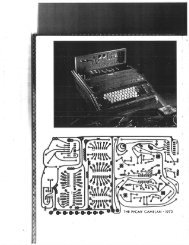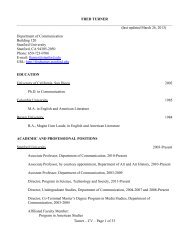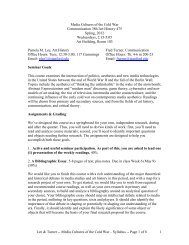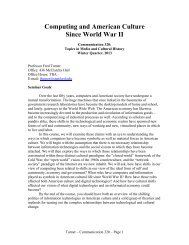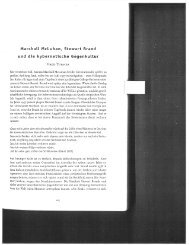Burning Man at Google - Fred Turner - Stanford University
Burning Man at Google - Fred Turner - Stanford University
Burning Man at Google - Fred Turner - Stanford University
Create successful ePaper yourself
Turn your PDF publications into a flip-book with our unique Google optimized e-Paper software.
New Media & Society 11(1&2)<br />
the lobby of Building 43 <strong>at</strong> <strong>Google</strong>’s Mountain View, CA headquarters,<br />
presents something of a shock.The cool blond wood and carefully recessed<br />
lighting which have marked the power of industrial firms for decades have<br />
disappeared. In their place, plain white walls are posted with some two dozen<br />
unframed photographs of giant sculptures set out in a fl<strong>at</strong>, white desert and of<br />
fireworks exploding over the head of a giant neon stick figure. On the floor<br />
above, another 30 images line the hallways and overlook an in-house cafe and<br />
pool table. In these pictures, shirtless men in pantaloons spin fire-tipped<br />
b<strong>at</strong>ons in the dark. A tiny clapboard house with a bicycle out front stands<br />
alone on an empty plain, while a two story-tall chandelier lies crashed to the<br />
ground, baking under the sun.<br />
To the thousands of San Francisco Bay area programmers, marketers and<br />
technical executives who spend a week there every August, these images are<br />
instantly recognizable.They depict <strong>Burning</strong> <strong>Man</strong>, an annual celebr<strong>at</strong>ion of art<br />
and temporary community staged in the Black Rock Desert, Nevada. Begun<br />
some 20 years ago with the burning of a wooden effigy on a San Francisco<br />
beach and l<strong>at</strong>er moving inland, <strong>Burning</strong> <strong>Man</strong> now draws more than<br />
35,000 participants each year (<strong>Burning</strong> <strong>Man</strong> Organiz<strong>at</strong>ion, 2005a). A gre<strong>at</strong><br />
many come from the San Francisco Bay area and work in the region’s<br />
high-technology industries (<strong>Burning</strong> <strong>Man</strong> Organiz<strong>at</strong>ion, 2005b; Gilmore,<br />
2005; Kozinets, 2002). In the last week of August, they pile into everything<br />
from ancient Honda Civics to 32-foot RVs and drive out into an alkali<br />
desert, a dusty plain completely devoid of w<strong>at</strong>er, where daytime temper<strong>at</strong>ures<br />
can reach 110 degrees and nights can near the freezing mark.They set up<br />
geodesic domes and tent cities, pir<strong>at</strong>e radio st<strong>at</strong>ions, elabor<strong>at</strong>e computer<br />
networks and huge, if temporary, dance clubs.They hold lectures, throw<br />
parties and traverse the desert in wh<strong>at</strong> passes for public transport<strong>at</strong>ion: some<br />
500 art cars rigged to look like everything from furry mushrooms to<br />
fire-bre<strong>at</strong>hing dragons. On the penultim<strong>at</strong>e night of the week, they burn a 40<br />
foot-tall effigy of a man.<br />
The question is: why? Wh<strong>at</strong> does <strong>Burning</strong> <strong>Man</strong> offer to workers in<br />
computer-rel<strong>at</strong>ed industries th<strong>at</strong> justifies their often extraordinary efforts to<br />
particip<strong>at</strong>e in it? Over the years, <strong>Burning</strong> <strong>Man</strong> has been depicted often in the<br />
popular media as a desert bacchanal, rife with public nudity and drug use. On<br />
the scholarly side, it has been studied largely as an example of a new social form,<br />
one which incorpor<strong>at</strong>es the syncretic religious impulses historically common to<br />
West Coast countercultures and the pro-art, anti-consumerist sentiments of<br />
contemporary do-it-yourself culture (Chen, 2004; Gilmore, 2005; Gilmore and<br />
Van Proyen, 2005; Kozinets, 2002; see also Hume and McPhillips, 2006;<strong>Turner</strong>,<br />
2006). Both of these accounts are true enough, but neither explains <strong>Burning</strong><br />
<strong>Man</strong>’s appeal to technologists. Since st<strong>at</strong>istics on the employment p<strong>at</strong>terns of<br />
<strong>Burning</strong> <strong>Man</strong> <strong>at</strong>tendees have never been kept, it is impossible to determine<br />
74



